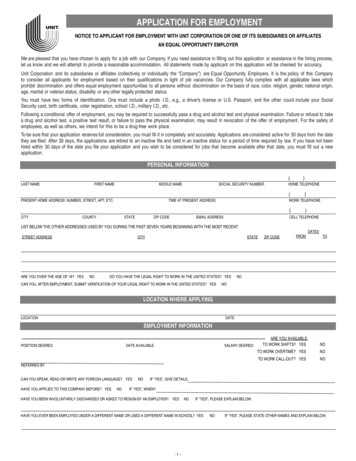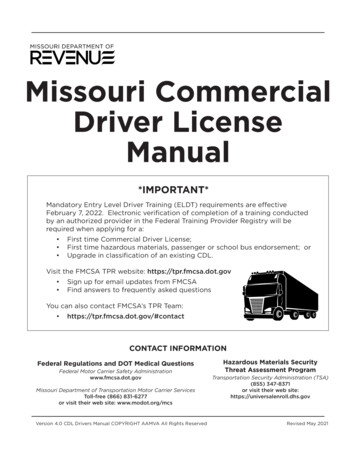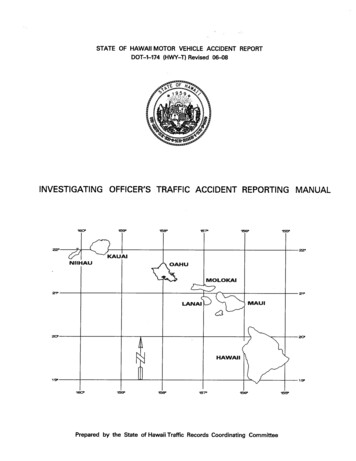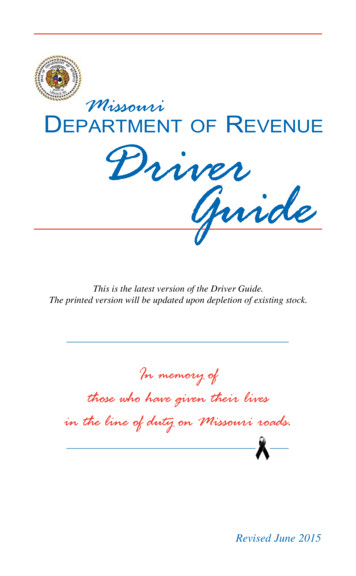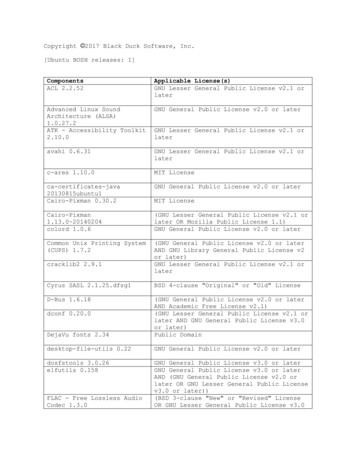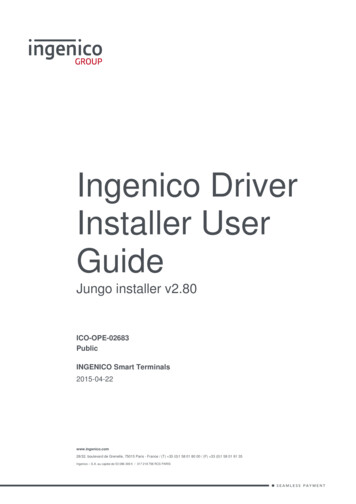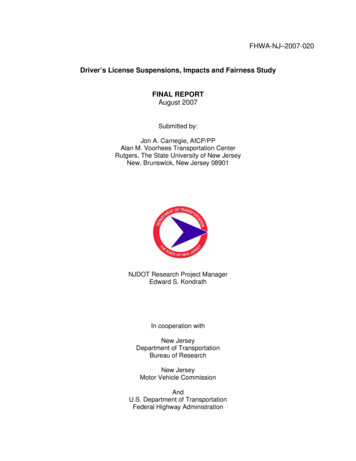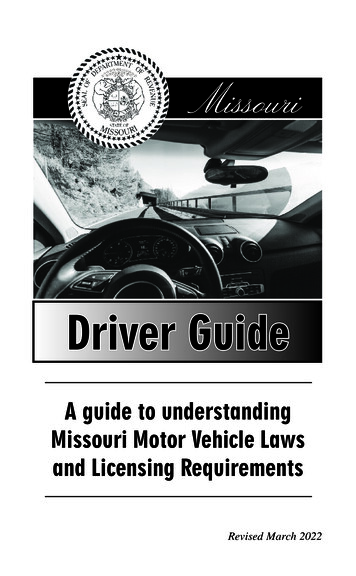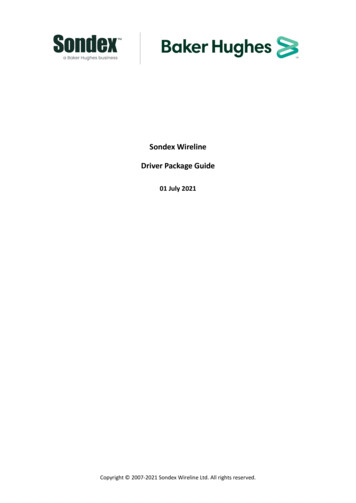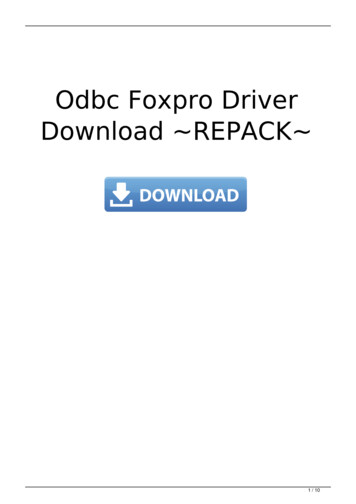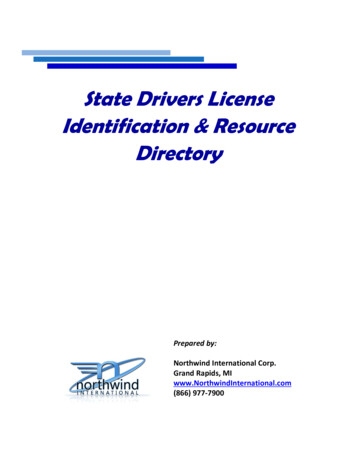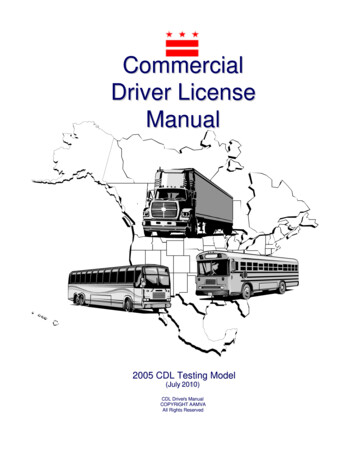
Transcription
ModelCommercialDriver LicenseManual2005 CDL Testing Model(July 2010)2007)CDL Driver’s ManualCOPYRIGHT AAMVAAll Rights Reserved
This material is based upon work supported by the Federal Motor CarrierSafety Administration under Cooperative Agreement No. DTFH61-97-X00017. Any opinions, findings, conclusions or recommendations expressed inthis publication are those of the Author(s) and do not necessarily reflect theview of the Federal Motor Carrier Safety Administration.
Table Of ContentsIntroduction . 1-1Driving Safely . 2-1Transporting Cargo Safely . 3-1Transporting Passengers Safely . 4-1Air Brakes . 5-1Combination Vehicles . 6-1Doubles and Triples . 7-1Tank Vehicles . 8-1Hazardous Materials. 9-1School Bus . 10-1Pre-Trip Vehicle Inspection . 11-1Basic Vehicle Control Skills Test . 12-1On-Road Driving . 1
2005 Model Commercial Driver’s License ManualDo You Need a CDL?Section 1INTRODUCTIONNoThis Section Covers Commercial Driver License TestsDriver DisqualificationsOther Safety RulesYesIs the vehicleacombinationvehicletowing a unitover 10,000poundsGVWR?There is a federal requirement that each state haveminimum standards for the licensing of commercialdrivers.This manual provides driver license testinginformation for drivers who wish to have acommercial driver license (CDL). This manual doesNOT provide information on all the federal andstate requirements needed before you can drive acommercial motor vehicle (CMV). You may have tocontact your state driver licensing authority foradditional information.Does thesingleYesvehicle havea GVWRover 26,000pounds?Any single vehicle with a gross vehicle weightrating (GVWR) of 26,001 pounds or more.A combination vehicle with a gross combinationweight rating of 26,001 or more pounds, if thetrailer(s) has a GVWR of 10,001 or more pounds.Youneed aClass ACDL.YesYouneed aClass BCDL.NoIs the vehicledesigned tocarry 16 ormore people(includingthe driver)?A vehicle designed to transport 16 or morepassengers (including the driver).Any size vehicle which requires hazardousmaterial placards or is carrying material listed asa select agent or toxin in 42 CFR part 73.Federal regulations through the Department ofHomeland Security require a background checkand fingerprinting for the Hazardous Materialsendorsement. Contact your local department ofdriver licensing for more information.YesYouneed aClass CCDL.NoNoDoes thevehiclerequirehazardousmaterialplacards ortransport aselect agentor toxin?(Your state may have additional definitions ofCMVs.)Section 1 - IntroductionYesNoYou must have a CDL to operate:To get a CDL, you must pass knowledge and skillstests. This manual will help you pass the tests.This manual is not a substitute for a truck drivertraining class or program. Formal training is themost reliable way to learn the many special skillsrequired for safely driving a large commercialvehicle and becoming a professional driver in thetrucking industry. Figure 1.1 helps you determine ifyou need a CDLDoes the vehicle orcombination of vehicleshave a manufacturer’sweight rating (GVWR)over 26,000 pounds?YesYouneed aClass CCDL.NoYou DO NOTneed a CDL.NOTE:A bus may be Class A, B, or C depending on whetherthe GVWR is over 26,001 pounds or is a combinationvehicle.Figure 1.1Page 1-1
2005 Model Commercial Driver’s License Manual1.1 – Commercial Driver License Tests1.1.1 – Knowledge TestsYou will have to take one or more knowledge tests,depending on what class of license and whatendorsements you need. The CDL knowledgetests include:The general knowledge test, taken by allapplicants.The passenger transport test, taken by all busdriver applicants.similar. The examiner will tell you how each controltest is to be done.On-road Test. You will be tested on your skill tosafely drive your vehicle in a variety of trafficsituations. The situations may include left and rightturns, intersections, railroad crossings, curves, upand down grades, single or multi-lane roads,streets, or highways. The examiner will tell youwhere to drive.Figure 1.2 details which sections of this manualyou should study for each particular class oflicense and for each endorsement.The air brakes test, which you must take if yourvehicle has air brakes, including air overhydraulic brakes.What Sections Should You Study?LICENSEENDORSEMENTTYPE2XXX3XXX1.1.2 – Skills Tests6XIf you pass the required knowledge test(s), you cantake the CDL skills tests. There are three types ofgeneral skills that will be tested: pre-trip inspection,basic vehicle control, and on-road driving. Youmust take these tests in the type of vehicle forwhich you wish to be licensed. Any vehicle thathas components marked or labeled cannot beused for the Pre-Trip Inspection Test.7Section 1 - IntroductionXXXBasic Vehicle Control. You will be tested on yourskill to control the vehicle. You will be asked tomove your vehicle forward, backward, and turn itwithin a defined area. These areas may be markedwith traffic lanes, cones, barriers, or somethingX45*Pre-trip Vehicle Inspection. You will be tested tosee if you know whether your vehicle is safe todrive. You will be asked to do a pre-trip inspectionof your vehicle and explain to the examiner whatyou would inspect and why.XSchool BusXPassengerXTank VehiclesXDouble / Triple1HazardousMaterialsThe School Bust test, required if you want todrive a school bus.Class CThe doubles/triples test, required if you want topull double or triple trailers.Class BThe tanker test, required if you want to haul aliquid or liquid gas in a permanently mountedcargo tank rated at 119 gallons or more or aportable tank rated at 1,000 gallons or more.Sections to StudyThe hazardous materials test, required if youwant to haul hazardous materials as defined in49 CFR 383.5. In order to obtain thisendorsement you are also required to pass aTransportation Security Administration (TSA)background check.Class AThe combination vehicles test, which is requiredif you want to drive combination vehicles.XXXXXX8X9XX10X11XXXXX12XXXXX13XXXXX*Study section 5 if you plan to operate vehiclesequipped with air brakes.Figure 1.2 – What to StudyPage 1-2
2005 Model Commercial Driver’s License Manual1.2 – CDL Disqualifications1.2.1 – GeneralYou may not drive a commercial motor vehicle ifyou are disqualified for any reason.1.2.2 – Alcohol, Leaving the Scene of anAccident, and Commission of a FelonyIt is illegal to operate a CMV if your blood alcoholconcentration (BAC) is .04% or more. If youoperate a CMV, you shall be deemed to havegiven your consent to alcohol testing.You will lose your CDL for at least one year for afirst offense for:Driving a CMV if your blood alcoholconcentration is .04% or higher.Driving a CMV under the influence of alcohol.Refusing to undergo blood alcohol testing.Driving a CMV while under the influence of acontrolled substance.without the properendorsements.classofCDLand/orYou will lose your CDL:For at least 60 days if you have committed twoserious traffic violations within a three-yearperiod involving a CMV.For at least 120 days for three or more serioustraffic violations within a three-year periodinvolving a CMV.1.2.4 – Violation of Out-of-Service OrdersYou will lose your CDL:[For at least 90 days if you have committed yourfirst violation of an out-of-service order.For at least one year if you have committed twoviolations of an out-of-service order in a ten-yearperiod.For at least three years if you have committedthree or more violations of an out-of-serviceorder in a ten-year period].Leaving the scene of an accident involving aCMV.1.2.5 – Railroad-highway Grade CrossingViolationsCommitting a felony involving the use of a CMV.You will lose your CDL:Driving a CMV when the CDL is suspended.For at least 60 days for your first violation.Causing a fatality through negligent operation ofa CMV.For at least 120 days for your second violationwithin a three-year period.You will lose your CDL for at least three years ifthe offense occurs while you are operating a CMVthat is placarded for hazardous materials.You will lose your CDL for life for a second offense.You will lose your CDL for life if you use a CMV tocommit a felony involving controlled substances.You will be put out-of-service for 24 hours if youhave any detectable amount of alcohol under.04%.1.2.3 – Serious Traffic ViolationsSerious traffic violations are excessive speeding(15 mph or more above the posted limit), recklessdriving, improper or erratic lane changes, followinga vehicle too closely, traffic offenses committed ina CMV in connection with fatal traffic accidents,driving a CMV without obtaining a CDL or having aCDL in the driver’s possession, and driving a CMVSection 1 - IntroductionFor at least one year for your third violationwithin a three-year period.These violations include violation of a federal, stateor local law or regulation pertaining to one of thefollowing six offenses at a railroad-highway gradecrossing:For drivers who are not required to always stop,failing to stop before reaching the crossing if thetracks are not clear.For drivers who are not required to always stop,failing to slow down and check that the tracksare clear of an approaching train.For drivers who are always required to stop,failing to stop before driving onto the crossing.For all drivers failing to have sufficient space todrive completely through the crossing withoutstopping.For all drivers failing to obey a traffic controldevice or the directions of an enforcementofficial at the crossing.Page 1-3
2005 Model Commercial Driver’s License ManualFor all drivers failing to negotiate a crossingbecause of insufficient undercarriage clearance.1.2.6 – Hazardous Materials EndorsementBackground Check and DisqualificationsIf you require a hazardous materials endorsementyou will be required to submit your fingerprints andbe subject to a background check.You will be denied or you will lose your hazardousmaterials endorsement if you:Are not a lawful permanent resident of theUnited States.Renounce your United States citizenship.Are wanted or under indictment for certainfelonies.Have a conviction in military or civilian court forcertain felonies.Have been adjudicated as a mental defective orcommitted to a mental institution.Are considered to pose a security threat asdetermined by the Transportation SecurityAdministration.The background check procedures vary fromjurisdiction to jurisdiction. Your licensing agencywill provide you with all the information you needto complete the required TSA background checkprocedures.1.2.7 – Traffic Violations in Your PersonalVehicleThe Motor Carrier Safety Improvement Act(MCSIA) of 1999 requires a CDL holder to bedisqualified from operating a commercial motorvehicle if the CDL holder has been convicted ofcertain types of moving violations in theirpersonal vehicle.If your privilege to operate your personal vehicle isrevoked, cancelled, or suspended due to violationsof traffic control laws (other than parking violations)you will also lose your CDL driving privileges.If your privilege to operate your personal vehicle isrevoked, cancelled, or suspended due to alcohol,controlled substance or felony violations, you willlose your CDL for 1 year. If you are convicted of asecond violation in your personal vehicle or CMVyou will lose your CDL for life.If your license to operate your personal vehicle isrevoked, cancelled, or suspended you may notobtain a “hardship” license to operate a CMV.Section 1 - Introduction1.3 – Other CDL RulesThere are other federal and state rules that affectdrivers operating CMVs in all states. Among themare:You cannot have more than one license. If youbreak this rule, a court may fine you up to 5,000 or put you in jail and keep your homestate license and return any others.You must notify your employer within 30 days ofconviction for any traffic violations (exceptparking). This is true no matter what type ofvehicle you were driving.You must notify your motor vehicle licensingagency within 30 days if you are convicted inany other jurisdiction of any traffic violation(except parking). This is true no matter whattype of vehicle you were driving.You must notify your employer within twobusiness days if your license is suspended,revoked, or canceled, or if you are disqualifiedfrom driving.You must give your employer information on alldriving jobs you have held for the past 10 years.You must do this when you apply for acommercial driving job.No one can drive a commercial motor vehiclewithout a CDL. A court may fine you up to 5,000 or put you in jail for breaking this rule.If you have a hazardous materials endorsementyou must notify and surrender your hazardousmaterials endorsement to the state that issuedyour CDL within 24 hours of any conviction orindictment in any jurisdiction, civilian or military,for, or found not guilty by reason of insanity of adisqualifying crime listed in 49 CFR 1572.103;who is adjudicated as a mental defective orcommitted to a mental institution as specified in49 CFR 1572.109; or who renounces his or herU. S. citizenship;Your employer may not let you drive acommercial motor vehicle if you have more thanone license or if you’re CDL is suspended orrevoked. A court may fine the employer up to 5,000 or put him/her in jail for breaking thisrule.All states are connected to one computerizedsystem to share information about CDL drivers.The states will check on drivers' accidentrecords to be sure that drivers do not have morethan one CDL.You must be properly restrained by a safety belt atall times while operating a commercial motorPage 1-4
2005 Model Commercial Driver’s License Manualvehicle. The safety belt design holds the driversecurely behind the wheel during a crash, helpingthe driver to control the vehicle and reduces thechance of serious injury or death. If you do notwear a safety belt, you are four times more likely tobe fatally injured if you are thrown from the vehicle.Your state may have additional rules that you mustalso obey.1.4 – International Registration PlanInternational Fuel Tax AgreementIf you operate a CDL required vehicle in interstatecommerce, the vehicle, with few exceptions, isrequired to be registered under the InternationalRegistration Plan (IRP) and the International FuelTax Agreement (IFTA). These federally mandatedprograms provide for the equitable collection anddistribution of vehicle license fees and motor fuelstaxes for vehicles traveling throughout the 48contiguous United States and 10 Canadianprovinces.Under the IRP, jurisdictions must registerapportioned vehicles which includes issuinglicense plates and cab cards or proper credentials,calculate, collect and distribute IRP fees, auditcarriers for accuracy of reported distance and feesand enforce IRP requirements.Registrant responsibilities under the Plan includeapplying for IRP registration with base jurisdiction,providing proper documentation for registration,paying appropriate IRP registration fees, properlydisplaying registration credentials, maintainingaccurate distance records, and making recordsavailable for jurisdiction review.The basic concept behind IFTA is to allow alicensee (motor carrier) to license in a basejurisdiction for the reporting and payment of motorfuel use taxes.Under the IFTA, a licensee is issued one set ofcredentials which will authorize operations throughall IFTA member jurisdictions. The fuel use taxescollected pursuant to the IFTA are calculatedbased on the number of miles (kilometers) traveledand the number of gallons (liters) consumed in themember jurisdictions. The licensee files onequarterly tax return with the base jurisdiction bywhich the licensee will report all operations throughall IFTA member jurisdictions.Section 1 - IntroductionIt is the base jurisdiction's responsibility to remitthe taxes collected to other member jurisdictionsand to represent the other member jurisdictions inthe tax collection process, including theperformance of audits.An IFTA licensee must retain records to supportthe information reported on the IFTA quarterly taxreturnThe IRP registrant and the IFTA licensee maybe the vehicle owner or the vehicle operator.The requirement for acquiring IRP plates for avehicle and IFTA license for a motor carrier isdetermined by the definitions from the IRP Planand the IFTA for Qualified Vehicle and QualifiedMotor Vehicle:For purposes of IRP:A Qualified Vehicle is (except as providedbelow) any Power Unit that is used orintended for use in two or more MemberJurisdictions and that is used for thetransportation of persons for hire or designed,used, or maintained primarily for thetransportation of property, and:(i) has two Axles and a gross Vehicle weight orregistered gross Vehicle weight inexcess of 26,000 pounds (11,793.401kilograms), or(ii) has three or more Axles, regardless ofweight, or(iii) is used in combination, when the grossVehicle weight of such combination exceeds26,000 pounds (11,793.401 kilograms).While similar, the Qualified Motor Vehicle inIFTA means a motor vehicle used, designed, ormaintained for transportation of persons orproperty and:1) Having two axles and a gross vehicleweight or registered gross vehicleweight exceeding 26,000 pounds or11,797 kilograms; or2) Having three or more axles regardlessof weight; or3) Is used in combination, when theweight of such combination exceeds26,000 punds or 11,797 kilograms grossvehicle or registered gross vehicleweight. Qualified Motor Vehicle doesnot include recreational vehicles.Page 1-5
2005 Model Commercial Driver’s License ManualIf the vehicle you operate is registered under IRPand you are a motor carrier licensed under IFTA,then you are required to comply with themandatory record keeping requirements foroperating the vehicle. A universally acceptedmethod of capturing this information is through thecompletion of an Individual Vehicle DistanceRecord (IVDR), sometimes times referred to as aDriver Trip Report. This document reflects thedistance traveled and fuel purchased for a vehiclethat operates interstate under apportioned (IRP)registration and IFTA fuel tax credentials.Although the actual format of the IVDR may vary,the information that is required for proper recordkeeping does not.In order to satisfy the requirements for IndividualVehicle Distance Records, these documents mustinclude the following information:DistancePer Article IV of the IRP Plan(i) Date of trip (starting and ending)(ii) Trip origin and destination – City and Stateor Province(iii) Route(s) of travel(iv) Beginning and ending odometer orhubodometer reading of the trip(v) Total distance traveled(vi) In-Jurisdiction distance(vii) Power unit number or vehicle identificationnumber.FuelPer Section P560 of the IFTA ProceduresManual.300 An acceptable receipt or invoice mustinclude, but shall not be limited to, thefollowing:.005 Date of purchase.010 Seller's name and address.015 Number of gallons or liters purchased;.020 Fuel type.025 Price per gallon or liter or total amount ofsale.030 Unit number or other unique vehicleidentifier.035 Purchaser's nameAn example of an IVDR that must be completed inits entirety for each trip can be found in Figure 1below. Each individual IVDR should be filled outfor only one vehicle. The rules to follow whentrying to determine how and when to log anodometer reading are the following:Section 1 - Introduction At the beginning of the dayWhen leaving the state or provinceAt the end of the trip/dayNot only do the trips need to be logged, but the fuelpurchases need to be documented as well. Youmust obtain a receipt for all fueling and include it withyour completed IVDR.Make sure that any trips that you enter are alwaysfilled out in descending order and that your tripsinclude all state/provinces that you traveled throughon your route.There are different routes that a driver may take,and most of the miles may be within one state orprovince. Whether or not the distance you travel isprimarily in one jurisdiction or spread amongseveral jurisdictions, all information for the tripmust be recorded. This includes the dates, theroutes, odometer readings and fuel purchases.By completing this document in full and keeping allrecords required by both the IRP and the IFTA, youwill have ensured that you and your company arein compliance with all State and Provincial lawssurrounding fuel and distance record keepingrequirements.The IVDR serves as the source document for thecalculation of fees and taxes that are payable tothe jurisdictions in which the vehicle is operated, sothese original records must be maintained for aminimum of four years.In addition, these records are subject to audit bythe taxing jurisdictions. Failure to maintaincomplete and accurate records could result infines, penalties and suspension or revocation ofIRP registrations and IFTA licenses.For additional information on the IRP and therequirements related to the IRP, contact your basejurisdiction motor vehicle department or IRP, Inc.the official repository for the IRP. Additionalinformation can be found on the IRP, Inc. websiteat www.irponline.org. There is a training video onthe website home page available in English,Spanish and FrenchFor additional information on IFTA and therequirements related to IFTA, contact theappropriate agency in your base jurisdiction. Youwill also find useful information about theAgreement at the official repository of IFTA athttp://www.iftach.org/index.php.Page 1-6
2005 Model Commercial Driver’s License ManualFigure 1 – Individual Vehicle Mileage & Fuel Record (Example)Section 1 - IntroductionPage 1-7
2005 Model Commercial Driver’s License ManualThis page intentionally left blank.Section 1 - IntroductionPage 1-8
2005 Commercial Driver’s License ManualSection 2DRIVING SAFELYThis Section Covers Vehicle InspectionBasic Control of Your VehicleShifting GearsSeeingCommunicatingSpace ManagementControlling Your SpeedSeeing HazardsDistracted DrivingAggressive Drivers/Road RageNight DrivingDriving in FogWinter DrivingHot Weather DrivingRailroad-highway CrossingsMountain DrivingDriving EmergenciesAntilock Braking SystemsSkid Control and RecoveryAccident ProceduresFiresAlcohol, Other Drugs, and DrivingStaying Alert and Fit to DriveHazardous Materials RulesThis section contains knowledge and safe drivinginformation that all commercial drivers shouldknow. You must pass a test on this information toget a CDL. This section does not have specificinformation on air brakes, combination vehicles,doubles, or passenger vehicles. When preparingfor the Pre-trip Inspection Test, you must reviewthe material in Section 11 in addition to theinformation in this section. This section does havebasic information on hazardous materials (HazMat)that all drivers should know. If you need a HazMatendorsement, you should study Section 9.2.1 – Vehicle Inspection2.1.1 – Why InspectSafety is the most important reason you inspectyour vehicle, safety for yourself and for other roadusers.Section 2 – Driving SafelyA vehicle defect found during an inspection couldsave you problems later. You could have abreakdown on the road that will cost time anddollars, or even worse, a crash caused by thedefect.Federal and state laws require that drivers inspecttheir vehicles. Federal and state inspectors alsomay inspect your vehicles. If they judge the vehicleto be unsafe, they will put it "out of service" until itis fixed.2.1.2 – Types of Vehicle InspectionPre-trip Inspection. A pre-trip inspection will helpyou find problems that could cause a crash orbreakdown.During a Trip. For safety you should:Watch gauges for signs of trouble.Use your senses to check for problems (look,listen, smell, feel).Check critical items when you stop: Tires, wheels and rims. Brakes. Lights and reflectors. Brake and electrical connections to trailer. Trailer coupling devices. Cargo securement devices.After-trip Inspection and Report. You should doan after-trip inspection at the end of the trip, day, ortour of duty on each vehicle you operated. It mayinclude filling out a vehicle condition report listingany problems you find. The inspection report helpsa motor carrier know when the vehicle needsrepairs.2.1.3 – What to Look ForTire ProblemsToo much or too little air pressure.Bad wear. You need at least 4/32-inch treaddepth in every major groove on front tires. Youneed 2/32 inch on other tires. No fabric shouldshow through the tread or sidewall.Cuts or other damage.Tread separation.Dual tires that come in contact with each otheror parts of the vehicle.Mismatched sizes.Radial and bias-ply tires used together.Page 2-1
2005 Commercial Driver’s License ManualCut or cracked valve stems.Leaking shock absorbers.Regrooved, recapped, or retreaded tires on thefront wheels of a bus. These are prohibited.Torque rod or arm, u-bolts, spring hangers, orother axle positioning parts that are cracked,damaged, or missing.Wheel and Rim ProblemsDamaged rims.Rust around wheel nuts may mean the nuts areloose--check tightness. After a tire has beenchanged, stop a short while later and re-checktightness of nuts.Air suspension systems that are damagedand/or leaking. See Figure 2.4.Any loose, cracked, broken, or missing framemembers.Missing clamps, spacers, studs, or lugs meansdanger.Mismatched, bent, or cracked lock rings aredangerous.Wheels or rims that have had welding repairsare not safe.Bad Brake Drums or ShoesCracked drums.Shoes or pads with oil, grease, or brake fluid onthem.Shoes worn dangerously thin, missing, orbroken.Steering System DefectsMissing nuts, bolts, cotter keys, or other parts.Figure 2.1Bent, loose, or broken parts, such as steeringcolumn, steering gear box, or tie rods.If power steering equipped, check hoses,pumps, and fluid level; check for leaks.Steering wheel play of more than 10 degrees(approximately 2 inches movement at the rim ofa 20-inch steering wheel) can make it hard tosteer.Suspension System Defects. The suspensionsystem holds up the vehicle and its load. It keepsthe axles in place. Therefore, broken suspensionparts can be extremely dangerous. Look for:Spring hangers that allow movement of axlefrom proper position. See Figure 2.2.Cracked or broken spring hangers.Missing or broken leaves in any leaf spring. Ifone-fourth or more are missing, it will put thevehicle "out of service", but any defect could bedangerous. See Figure 2.3.Broken leaves in a multi-leaf spring or leavesthat have shifted so they might hit a tire or otherpart.Section 2 – Driving SafelyFigure 2.2Page 2-2
2005 Commercial Driver’s License ManualFire extinguisher(s).Spare electrical fuses (unless equipped withcircuit breakers).Warning devices for parked vehicles (forexample, three reflective warning triangles or 6fusees or 3 liquid burning flares).Cargo (Trucks). You must make sure the truck isnot overloaded and the cargo is balanced andsecured before each trip. If the cargo containshazardous materials, you must inspect for properpapers and placarding.2.1.4 – CDL Pre-trip Vehicle Inspection TestFigure 2.3In order to obtain a CDL you will be required topass a pre-trip vehicle inspection test. You will betested to see if you know whether your vehicle issafe to drive. You will be asked to do a pre-tripinspection of your vehicle and explain to theexaminer what you would inspect and why. Thefollowing seven-step inspection method should beuseful.2.1.5 – Seven-step Inspection MethodMethod of Inspection. You should do a pre-tripinspection the same way each time so you willlearn all the steps and be less likely to forgetsomething.Approaching the Vehicle. Notice generalcondition. Look for damage or vehicle leaning toone side. Look under the vehicle for fresh oil,coolant, grease, or fuel leaks. Check the areaaround the vehicle for hazards to vehiclemovement (people, other vehicles, objects, lowhanging wires, limbs, etc.).Figure 2.4Exhaust System Defects. A broken exhaustsystem can let poison fumes into the cab orsleeper berth. Look for:Loose, broken, or missing exhaust pipes,mufflers, tailpipes, or vertical stacks.Loose, broken, or missing mounting brackets,clamps, bolts, or nuts.Exhaust system parts rubbing against fuelsystem parts, tires, or other moving parts ofvehicle.Vehicle Inspection GuideStep 1: Vehicle OverviewReview Last Vehicle Inspection Report. Driversmay have to make a vehicle inspection report inwriting each day. The motor carrier must repair anyitems in the report that affect safety and certify onthe report that repairs were made or wereunnecessary. You must sign the report only ifdefects were noted and certified to be repaired ornot needed to be repaired.Step 2: Check Engine CompartmentExhaust system parts that are leaking.Emergency Equipment. Vehicles must beequipped with emergency equipment. Look for
This manual is not a substitute for a truck driver training class or program. Formal training is the most reliable way to learn the many special skills required for safely driving a large commercial vehicle and becoming a professional driver in the trucking industry. Figure 1.1 helps you determine if you need a CDL Do You Need a CDL? No
